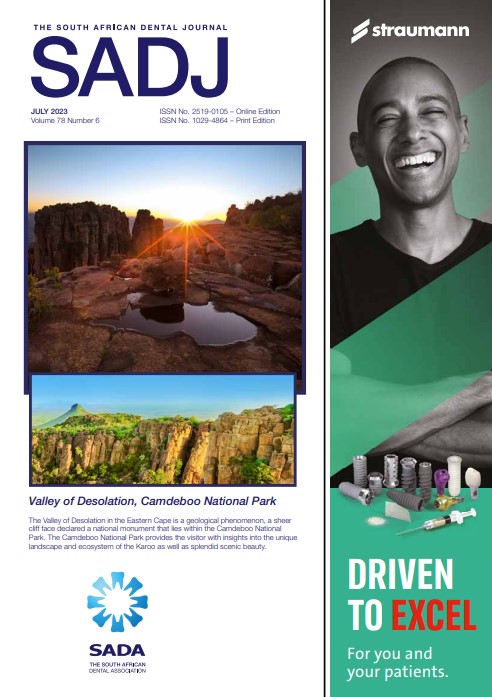Does providing “Compromised treatment” equate to “Compromised care” or could it be considered “Appropriatech”?
DOI:
https://doi.org/10.17159/sadj.v78i06.16911Keywords:
aesthetics, invasiveAbstract
Teeth are sensory structures that play a part in many different aspects of a patient’s life, including mastication, speech, smiling and aesthetics. As such they can affect both their functional and psychosocial wellbeing and quality of life. Unfortunately, these vital components can be lost due to caries, periodontal disease, dental trauma or iatrogenic damage. Dental practitioners should aim to provide treatment that will save and/or restore compromised or diseased teeth whenever possible. This may include direct
or indirect restorations, endodontics, periodontal therapy and even reimplantation or autotransplantation in specific cases.1 Despite the wide range of treatment possibilities, oral rehabilitation is often not available, accessible or affordable to all patients.2 To try to “provide treatment for the many”, cost-effective procedures may need to be considered. However, this cost-cutting cannot be achieved by “ignoring sound prosthodontic principles” and needs to have some form of quality control.2 This paper will give a brief review of
the controversial cervical margin relocation technique. It will then use this as an example for how a clinician can debate whether the provision of “compromised treatment” equates to inferior care, or if it could be considered appropriate for the given situation. They need to also ensure that the chosen treatment is safe, adheres to evidence-based principles and still provides quality of care.
Downloads
References
Clark D, Levin L ( 2019). In the Dental Implant era, why do we still bother saving teeth? J Endodontics. 45(12); S57-S65 DOI: https://doi.org/10.1016/j.joen.2019.05.014
Owen PC (2004). Appropriatech: prosthodontics for the many, not just the few. Int J Prosthodont. 17(3);261-262
Juloski J, Koken S, Ferrari M (2018). Cervical margin relocation in indirect adhesive restorations: a literature review. J Prosthodontic Research, 273-280 DOI: https://doi.org/10.1016/j.jpor.2017.09.005
Ferrari M, Koken S, Grandini S et al (2018). Influence of cervical margin relocation technique on periodontal health: 12-month results of a controlled trial. J Dentistry 70-76 DOI: https://doi.org/10.1016/j.jdent.2017.10.008
Dietschi D, Spreafico R (1998). Current clinical concepts for adhesive cementation of tooth-colored posterior restorations. Practical Period Aesthetic dentistry, 10 (1998) pp 47-54
Alhumaidan G, Raghad A, Al Asmari D, Alenezi A (2022). Clinical performance of indirect restorations with cervical margin relocation in posterior teeth, A systematic review. Dentistry review. Accessed at: https://doi.org/10.1016/j.dentre.2022.100034; Accessed on 20-06-2023. Pages 1-5 DOI: https://doi.org/10.1016/j.dentre.2022.100034
HPCSA Guidelines, Booklet 3. The National Patient’s Rights Charter. Page 2-3 Accessed at: http://www.hpcsa.co.za; Accessed on: 20-06-2023
Dworkin G, Zalta EN (2016). Stanford encyclopaedia of Philosophy. Accessed at: https://plato.stanford.edu/archives/fall2016/ entries/paternalism/. Accessed on: 27-06-2023
Beauchamps TI, Childress JF (2001). Principles of Biomedical Ethics. New York, Oxford University Press
Downloads
Published
Issue
Section
License

This work is licensed under a Creative Commons Attribution-NonCommercial 4.0 International License.





.png)